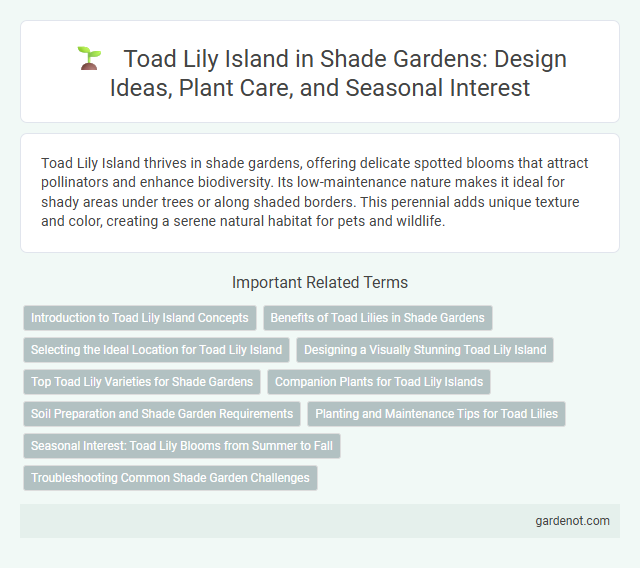Toad Lily Island thrives in shade gardens, offering delicate spotted blooms that attract pollinators and enhance biodiversity. Its low-maintenance nature makes it ideal for shady areas under trees or along shaded borders. This perennial adds unique texture and color, creating a serene natural habitat for pets and wildlife.
Introduction to Toad Lily Island Concepts
Toad Lily Island presents a unique approach to shade gardening by incorporating exotic Tricyrtis species known for their delicate, orchid-like flowers that bloom in late summer and fall. This concept emphasizes creating a naturalistic habitat mimicry, blending native ferns, hostas, and moisture-loving shrubs to support pollinators and enhance biodiversity. By focusing on soil moisture regulation, dappled light conditions, and organic mulching, Toad Lily Island ensures vibrant growth and prolonged bloom periods in shaded landscapes.
Benefits of Toad Lilies in Shade Gardens
Toad lilies thrive in shade gardens by providing late-season blooms when many other plants have finished flowering, enhancing garden interest through their unique, orchid-like spotted flowers. Their ability to tolerate deep shade and moist, well-drained soil makes them ideal for under-canopy planting in shaded areas. These resilient perennials also attract pollinators like bees and hummingbirds, promoting biodiversity within shade garden ecosystems.
Selecting the Ideal Location for Toad Lily Island
Choose a shaded, moist area with well-drained soil for Toad Lily Island to thrive, as Tricyrtis species prefer dappled sunlight and consistently damp conditions. Position the island near tall deciduous trees or shrubs to mimic their natural woodland habitat while protecting delicate blooms from harsh afternoon sun. Ensure the site has good air circulation to prevent fungal diseases common in humid, shaded gardens.
Designing a Visually Stunning Toad Lily Island
To design a visually stunning Toad Lily Island, prioritize planting clusters of Tricyrtis species with varying flower colors and patterns to create dynamic texture and depth. Incorporate rich, moist soil conditions with partial to full shade to mimic the toad lily's natural woodland habitat, enhancing bloom longevity and vibrancy. Surround the planting area with fern varieties and moss to provide a lush green backdrop that accentuates the intricate blossoms.
Top Toad Lily Varieties for Shade Gardens
Top toad lily varieties such as Tricyrtis hirta, Tricyrtis formosana, and Tricyrtis 'Samurai' thrive in shade gardens due to their preference for moist, well-drained soil and filtered light. These varieties showcase exotic, orchid-like blooms in late summer to fall, adding unique texture and color to shade garden settings. Their adaptability to low light and resistance to deer make them ideal for creating a vibrant toad lily island in shaded landscapes.
Companion Plants for Toad Lily Islands
Toad lily islands thrive when paired with companion plants that enjoy similar shade and moisture conditions, such as Japanese forest grass (Hakonechloa), foamflower (Tiarella), and ferns like the lady fern (Athyrium filix-femina). These companions create a textured, layered effect that highlights the toad lily's unique spotted blooms while maintaining soil moisture and minimizing weed growth. Incorporating hostas and astilbes further enhances the garden's visual appeal and ensures a harmonious shade garden ecosystem.
Soil Preparation and Shade Garden Requirements
Toad lily island thrives in well-drained, rich, and consistently moist soil enriched with organic matter to support its delicate root system. Ideal shade garden conditions include dappled sunlight or partial shade that mimics its native woodland habitat, preventing leaf scorch and promoting vibrant blooms. Maintaining a slightly acidic to neutral pH between 5.5 and 7.0 ensures optimal nutrient uptake and overall plant health in shade garden environments.
Planting and Maintenance Tips for Toad Lilies
Toad lily plantings thrive best in shaded, moist, and well-drained soil enriched with organic matter such as compost or leaf mold. Regular watering is essential to maintain consistent moisture, especially during dry spells, while applying a layer of mulch helps conserve soil moisture and suppress weeds. Pruning spent flowers and trimming back foliage in late fall promotes healthy growth and prevents disease, ensuring vibrant blooms throughout the growing season.
Seasonal Interest: Toad Lily Blooms from Summer to Fall
Toad Lily Island offers vibrant seasonal interest with its unique Toad Lily blooms that flourish from summer through fall. These exotic, orchid-like flowers brighten shaded garden areas with speckled petals in tones of purple, lavender, and white, attracting pollinators such as bees and hummingbirds. Their extended blooming period ensures continuous visual appeal and enhances the biodiversity of shade gardens during warmer months.
Troubleshooting Common Shade Garden Challenges
Toad lily islands thrive in low-light conditions but may face issues such as poor drainage, leading to root rot, and inadequate air circulation causing fungal diseases. Regularly monitoring soil moisture and ensuring rich, well-drained organic matter helps mitigate these problems. Applying mulch and spacing plants properly promotes healthy growth and reduces pest infestations in shade garden environments.
Toad lily island Infographic

 gardenot.com
gardenot.com